Spruce Reach Island: The Oregon Coast's Secret Rhododendron Garden, Part II
The Hinsdale Estate, Dean Creek, Near Reedsport
John M. Hammond
Bury Lancashire
England
Gordon K. Wylie
Creswell, Oregon
Part I in the Fall 2007 issue laid the historical foundation for the Hinsdale Estate garden. Part II describes the development of the garden. Part III in the Spring 2008 issue will conclude the series with a report by Gordon Wylie on Garden Visits, Discussions, Progress and Future.
The Development of Spruce Reach Island Garden
As and when business permitted, O. Howard Hinsdale much preferred to involve himself in outdoor pursuits. He was an avid hunter and travelled to Central Oregon to hunt for birds, he was a keen fisherman and regularly fished for salmon at the mouth of the Umpqua and for steelhead on the Rogue, but most of all he was a passionate gardener. Nancy Lee, a resident of Reedsport, noted that the Hinsdale family travelled all over the world collecting plants for their garden (10).
In the main garden, in the area that runs westwards from the entrance drive, alongside the ditch that parallels the highway, a number of mature large-leaved rhododendron species were planted in the early-1940s. These are likely to have been the earliest rhododendron plantings in the garden and included
R. falconeri
,
R. sinogrande
,
R. grande
,
R. fictolacteum
and
R. discolor
. Oral tradition has it that these plants originated from the collection of seedlings raised by the Oregon rhododendron pioneer James Barto, who had a homestead on the High Pass Road, near Junction City. The plants were probably amongst those that were sold by Barto's wife, Ruth Lamson Barto, after his untimely death in December 1940. Another mature species,
R. lacteum
, was planted closer to the house, but this eventually died; this plant probably originated from the same source. Barto had waited for many years to see his
R. lacteum
and
R. falconeri
seedlings flower, but sadly he died of cancer before they bloomed for the first time. Prior to WWII, and for a number of years after, there was probably no other source for acquiring large specimens of large-leaved rhododendron species on the West Coast.
In the late-1940s Evangeline N. Hinsdale, Howard's mother, went to live in the Portland area and this presented Howard with the opportunity to remodel Spruce Reach Island house and to landscape the gardens. It appears that the development of the house commenced in 1947 whilst Howard was still the driving force in Gardiner Lumber Company and he used his "crews" to construct the south wing, expand the east wing, then reconstruct and expand the west wing. This project also included raising the house to avoid flooding, which involved the felling of the crab-apple trees and jacking the entire original structure up on to new foundation posts. Howard had the dredge Sandpiper positioned in the river near the island and pumped up tons of sand and gravel to build up the elevation of the whole eastern end of the main property. The work on the house took a number of years to complete and this suggests that his approach reflects the way in which the garden was later developed. Also in 1947 he was instrumental in moving the First National Bank of Gardiner to a new site at Reedsport where it opened as the Umpqua National Bank with Howard as its president.
In 1951 Howard turned his attention to laying out and planting the garden, which totalled eight acres around the main house and extended from Highway #38 to the riverbank. This work was very carefully orchestrated. All the elements were brought together to create a garden in the style of a small traditional English country house and its woodland gardens, as they would have been in the period between the early-1900s and the on-set of WWII. The trees planted some years earlier at the western edge of the property provided shelter from the wind and other plantings formed an overhead canopy to produce a dappled effect of sun and shade. The entrance drive area, from the bridge at the highway to the front of the house, was laid out to contain the appropriate level of formality in regard to the plantings in the "island" beds, and also in the borders.
To the east and west of the main drive the woodland gardens were laid-out in the traditional manner, whilst to the rear of the house were other groupings of flowering shrubs and long stretches of lawn running along the banks of the Umpqua. Most gardens of this type contain a water feature in the form of an ornamental lake, ponds or a reflective canal and Spruce Reach Island was to be no exception. A canal runs inland from the river to the highway, sometimes referred to as the Hinsdale Slough, and this cuts off the eastern segment of garden, around two acres in extent, from the main garden. Originally the eastern segment was connected to the main garden by a bridge, constructed by Howard, composed of two massive red cedar logs that spanned the canal, with planks laid across the logs to form a roadway for vehicles and maintenance. This canal was utilised by Howard to good effect and the plantings on the sloping east bank were well positioned in longitudinal rows so their flowers would reflect in the water when viewed from the main garden.
Galen Baxter, now in his eighties and a Eugene Chapter member of the American Rhododendron Society (ARS), worked at the Long-Bell Mill on weekdays for about 34 years and, from around 1952, worked additional shifts at weekends for four or five years at the Spruce Reach Island property where he helped to lay out the garden and plant Howard's "acquisitions." Several areas in the western part of the garden were low-lying and swampy, so once again Howard had the dredge Sandpiper positioned in the river and used this to pump up an infill of gravel and sand to raise the level of the garden in some of these marshy areas. Terrace walkways were constructed throughout this part of the garden and these formed an intricate set of pathways between the plantings. Howard personally directed the landscaping operations that commenced in 1951, including instructing as to how the plants were to be handled and planted. Detailed preparations were made for planting each specimen in a location chosen by Howard; the soil was excavated and layers of gravel and sand were used to create drainage and to construct a suitably raised bed for each plant.
There was an average of four staff that worked on laying out the garden; Galen remembers the work was hard but Howard treated him well and paid him the same overtime rates as the rest of the crew. But, where did the plants come from?
In recent years the TV media would lead you to believe that "instant" gardens, landscaping and makeovers are something new and trendy. But little is new in horticulture; indeed, O. Howard Hinsdale may well have been a leader in the field! On first sight little appears to be known about his horticultural and forestry background, but it is clear that he was knowledgeable about trees and plants and he employed some most unusual techniques to acquire specimens to plant in his new garden.
Galen recalls that in the early-1950s Howard toured the more affluent areas of Portland, Oregon, searching for mature specimens of rhododendrons, camellias and magnolias in private gardens. When Howard found a plant he wanted he would knock on the front door of the house and offer the owner a figure in cash that was difficult to refuse. Money was no object to Howard in his quest and it is said that when he happened to locate a particularly good, large specimen he would offer in excess of $1000.00, an enormous sum of money in those days. With negotiations completed Howard would then arrange for his crew to "lift" the plant, secure it on a large flatbed truck and transport it to the Spruce Reach Island garden. On arrival at the garden the difficulties of getting a large flatbed truck into position, to gain access over the narrow bridge and along the driveway towards the house, caused chaos and major delays on Highway #38. In 1954 Howard purchased fifteen trees, mainly Himalayan cedars all 30 to 40 feet in height and almost as wide, from Lambert Gardens in Portland (23). A.B. Lambert was a specialist nurseryman who raised shrubs and trees, but as he probably did not expect to have a market for older trees this turned out to be the biggest tree-moving job in his experience. The largest specimen, 25,000 pounds of Himalayan cedar, including roots and protective sod, was valued at $750.00, and a crew of five spent four days digging the massive rootball from the garden. A specialist crane was required to lower the 42.5-foot tree, with a base circumference of 54 inches, to the bed of a large freight truck for the journey to Spruce Reach Island; three slightly smaller trees were dispatched on separate trucks, three hours apart, on the same day. Lifting and positioning the trees by crane on arrival at the garden must have been a tricky operation amidst the other plantings. Eleven other loads were to follow by truck over the next few days and the major delays to traffic at the entrance to Spruce Reach Island must have been a talking point in the local community.
So, the alternative option was for the crew to lift the plant, or tree, and transport it to a dock on the Willamette River where it would be loaded on to one of the U.R.N. Co.'s barges and shipped with other acquisitions to Reedsport. The plants were taken directly to the garden by barge where they were off-loaded by a barge-mounted crane, great care being taken to ensure the crane-slings did not damage the bark of the trunks during lifting operations. At least one specimen was so large that it took a whole barge to secure and move it and two cranes were used for lifting such an enormous specimen to prevent damaging the plant.
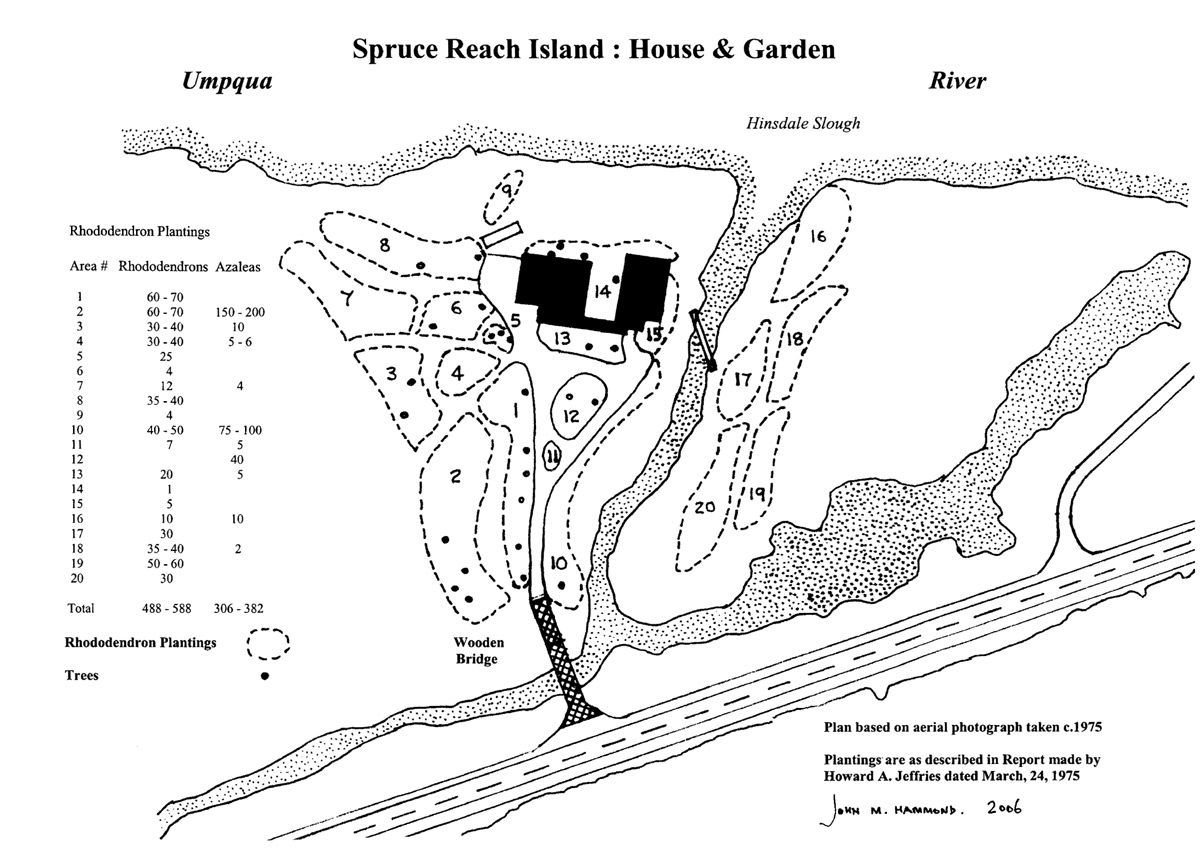
|
Two plants in the garden are very old, R. 'Cynthia' and
R. fortunei
, and these pre-date the raising of rhododendrons in Oregon; Howard's records give their age as dating back to around 1890 to 1895. Howard sourced his large mature plants from the Portland area and the earliest rhododendrons that are known of in Portland was a special shipment sent from England to use in a major display at the Lewis & Clark Centennial Exposition held in Portland in 1905. These plants would have needed to be 10 to 15 years old to be a suitable size for the display, so the dates given on the record cards do match. After the Exposition had finished some of the plants were used to create a roadside display area by the Portland Parks department; others fell into the hands of influential private individuals. At this stage some of the foregoing requires further verification, if that is practicable; however, there is little doubt that Spruce Reach contains two of the first rhododendrons to be introduced into Oregon.
There are many other old rhododendrons in the garden that are grafted on to
R. ponticum
rootstocks and, as this was not a methodology practiced commercially by the early nurserymen in the Pacific Northwest, it is likely that these were also originally imported from England. And, there are also a number of old camellias and magnolias that await identification.
There is no doubt that Howard had the ability to successfully extract, lift, transport, off-load and plant large specimens in pre-prepared locations in his newly landscaped garden. This type of work is by no means straightforward, particularly in an era when specialized equipment was not available, and how he had acquired this expertise is something of a mystery. Equally fascinating is how and where Howard acquired the knowledge to be able to create a landscape in the style of an English woodland garden. The same attention to detail and care was reflected in the plantings that were laid-out in the formal and woodland areas of the garden. An English-style garden would be expected to contain plants that could be found in such a garden, and this is exactly what Spruce Reach Island contains, some arranged in groupings ranging from 3 to 6 for "show." These include hybrids raised by Gill, Lowinsky, Mangles, Slowcock, Smith, Standish & Noble, and Waterer, all key rhododendron personalities from the late-19th and early-20th centuries.
In the authors' experience, it is unusual to find very old specimens of some of these early British hybrids in Oregon and we suspect that some plants may have been quite rare in the era that the garden was developed. Similar comments could apply to the camellias and magnolias, some of which are very old plants and more research work is needed to unravel their origins. And, as happened in England, the gardens at Spruce Reach Island have been overlaid with a range of the better hybrids that were raised in the inter-war years, i.e., 1920s and 1930s, some of which did not become available in the trade until after WWII. These include collections of hybrids raised by Aberconway, Crosfield, Loder, Rothschild, Stevenson, Swaythling and Williams, as well as the usual hybrids raised by Dutch breeders for the English market. These hybrids have been further enhanced by the acquisition of good forms of species rhododendrons and some of these were probably raised from seed by Oregon's early rhododendron pioneers.
By the early-1950s Howard had become friendly with John Henny of Brooks, Oregon, first president of the ARS, and they became partners in the establishment of a wine distribution business, said to be the first to support Oregon's fledgling wineries. John Henny and his brother Rudolph were farmers and both had rhododendron nurseries at Brooks, near Salem, and it is probable that the brothers provided Howard with the cultural advice. It is also likely that they provided Howard with location details when mature plants became available. Sometime in the mid-1950s Howard became a member of the Portland Chapter ARS. He is listed in the annual membership roster for the years 1962, 1963 & 1965, but copies of rosters for the earlier years of the chapter are proving difficult to locate. Somehow, he was able to acquire one of the original seedlings of R. 'Golden West', a Del James cross of c.1950 that was much sought after at the time on account of its Dresden yellow flowers that had a small red blotch. It would not be unreasonable to conclude that Howard and Del became friends. At different times, John Henny and Del James had both travelled to England to visit gardens and meet with the key rhododendron enthusiasts of the day. Was Howard inspired to do likewise?
Around 1953 Howard acquired the complete inventory of a nursery in the Portland area, including a number of large specimens that were probably stock and display plants. Despite various enquiries, including correspondence with the Portland Chapter ARS, this nursery remains unidentified. Over 1000 plants, mainly rhododendron species and hybrids, were transported by truck back to the garden and this amounted to the better part of 100 loads in total. So, Howard had more than just a passing interest in rhododendrons and companion plants and is a serious contender for the title of the original "instant gardener" in the Pacific Northwest. Galen Baxter summarized Howard's landscaping work in the following terms (6):
...On the east side of the entrance drive, after crossing the bridge over the ditch alongside the highway, there were a few large rhododendrons planted close to the highway, then around 40 smaller-leaved alpine types ran along the side of the drive up to the house. Between the rhododendrons and the west bank of the canal was a large iris garden. As the drive approached the house it segregated to form a large return circle and in the middle were two beds of evergreen azaleas and alpine type rhododendrons. On elevated areas of ground in the main garden, to the west of the entrance drive, between the highway and the riverbank, around 250 old-English, Dutch and German hybrids were planted interspersed with magnolia species, ornamental maples and dove trees. Along the river bank behind the house was a collection of around 20 specimen camellias. Over the 'cedar bridge', in the two acres of garden to the east of the canal, around 160 rhododendrons were planted four rows deep on the sloping bank, in parallel lines to the canal, with walkways between each row. These were mainly old English, a few Dutch and the occasional German hybrids and their careful positioning in 'theatre row' format enabled the reflections of their flowers in the canal to be seen from the house and the main garden. A number of trees behind the rhododendrons provided some shelter for these plantings.
To cater for the irrigation of the plantings Howard organised the construction of a concrete tank high up on a ridge of Dean Mountain, around half a mile to the south of the property. A water main was piped downhill, across the low-lying flatlands and under Highway #38 to serve a network of high-level sprinklers in the garden. Some of these sprinklers are still extant. A perennial topic amongst rhododendron enthusiasts is the various approaches they use to produce plant labels that have a long life. Howard devised an unusual method for tagging his plants; he placed the plant information in a very small glass bottle, sealed it with a cork and hung it from the branch of the plant or tree. Some of these bottles and labels remain to this date.
In the spring of 1955 Howard and Jane Hinsdale arranged the first annual open day of their garden in support of St. Mary's Episcopal Church of Gardiner. The open days were well supported by the local community and that held on Sunday, April 27th,1958, was featured, along with several photographs, in the Roseburg News-Review (22):
...One of the largest events to take place in Douglas County was enjoyed by several hundreds Sunday afternoon, when Mr. And Mrs. Hinsdale opened their beautiful five-acre garden and home on the Umpqua River near Reedsport as a benefit affair for St. Mary's Church of Gardiner.
...Members of St. Mary's Guild acted as hostesses for the occasion. This was the fourth annual garden tour and tea sponsored by the Guild at the Hinsdale garden and to date it was the largest. Even the weather co-operated and those enjoying the afternoon roamed the many paths lined with gorgeous rhododendrons and azaleas in a setting of evergreen trees. Many other very fine shrubs including camellias are included in the garden plantings, however the rhododendrons (with more than 100 species in the collection) and azaleas predominate.
...Not only residents from all parts of Oregon were on hand to enjoy the occasion, but a number of out-of-state residents seeing the magnificent color of the garden from the highway stopped and joined the tour. Those making the tour found it to be even more beautiful than they had imagined possible and those unable to make it this year are already making plans to attend the fifth garden tour and tea to be held in 1959.
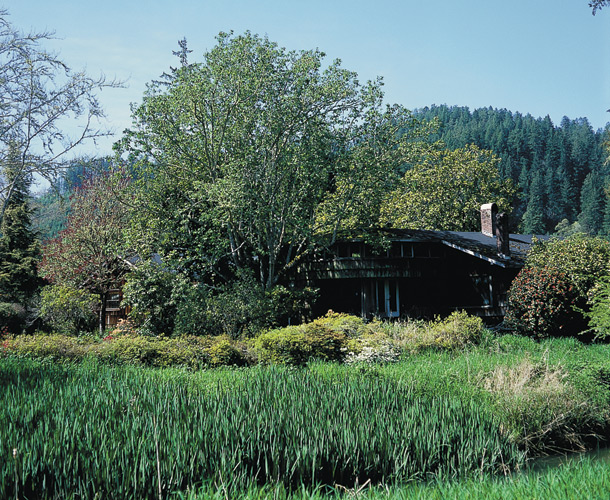
|
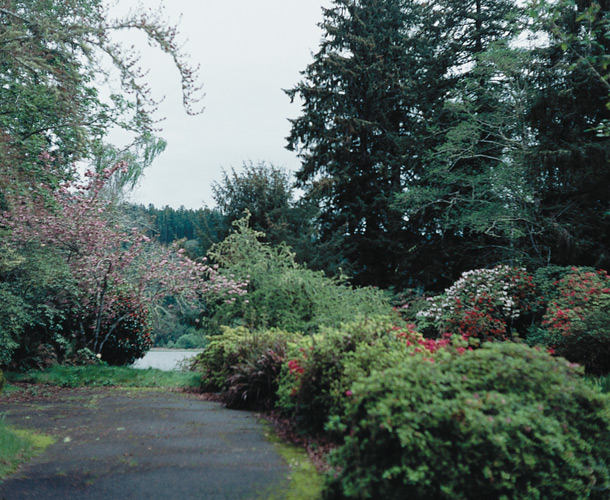
|
|
|
View toward house and river.
Photo by John Hammond |
View along circle drive to Umpqua River.
Photo by John Hammond |
Storms, Fires, Floods, Mergers and Shut-downs: The Tumultuous '60s on the Oregon Coast
The late-1950s and 1960s were tumultuous years for the Oregon Coast. Long-Bell Lumber Company thoroughly modernised their Gardiner mill, which was brought into operation in 1951 (17). The following year a 3.8-mile branch line was constructed from the Southern Pacific Railroad (S.P.R.) at Gardiner Junction to the mill. Two long trestle bridges were built to enable the new alignment to span a section of the Umpqua and run across Bolen Island. The Long-Bell logging operations in the Northwest were connected to the Southern Pacific Railroad via a number of spurs and these were collectedly named the Longview, Portland & Northern Railroad (L.P.&N.R.), incorporated in 1922. From its Longview headquarters the L.P.&N.R. controlled four geographically segregated short-lines that served Long-Bell's various logging operations and mills in the Northwest. A network of 72 miles of track included the 3.8 miles from Gardiner to its S.P.R. connection at Gardiner Junction. Long-Bell merged its entire Washington and Oregon operations with International Paper Co. in 1956; unfortunately, this was to be a "calm before the storm" scenario for the Gardiner mill (17).
On October 12th, 1962, the "Big Blow," known locally as the "Columbus Day Storm," caused major damage throughout the area. Frieda, a typhoon, had its beginnings in the South China Seas, swept across the central Pacific Ocean, the main body of the 500-mile diameter storm streaking eastwards towards California and then veering northwest to hit the Oregon Coast in the late-afternoon with the ferocity of a Category IV hurricane. One set of recording equipment broke when the winds exceeded 140mph and other records suggest the windstorm reached 160mph. Damage estimated at $170-200 million occurred in Oregon as the typhoon cut a swath, like a tornado, through the coastal communities then headed inland to the Willamette Valley (18). Mature Douglas fir and Western red cedar were snapped-off near the base and others uprooted whilst damage to buildings and services was colossal. Damage on Spruce Reach Island was overshadowed by the impact to Reedsport itself. But worse was to come. In 1964 there was a "100-Year" flood that badly affected the Umpqua River and its estuary. In Reedsport itself the waters were 3 feet deep in the post office and the surrounding area was badly flooded, including Spruce Reach Island. People reminisce about the legendary 100-Year storms, and others contend that such events are not "tied" to a particular cycle; however, given the devastation caused by the 1861 floods there is a grain of truth in the story.
Despite the size of his fortune and industrial interests, the "Oxbow Fire" of 1966 destroyed the majority of O. Howard Hinsdale's empire. This forest fire, one of the largest to occur in Oregon, started on August 20th in an area of forest near Oxbow Ridge, west of Cottage Grove, and burned approximately 42,274 acres, including 24,359 acres managed by the B.L.M., 17,601 acres owned by International Paper Co. and 915 acres of private land. In physical terms the fire extended over a massive area along the Smith River to Oxbow Ridge, south almost to the Umpqua River and north towards Mapleton from where the fire could clearly be seen (13).
As well as operating marine equipment, tugs and barges the U.R.N. Co. carried out road construction contracts using materials extracted by the sand and gravel plant. In a lengthy and heavily contested sequence of civil court actions, the company was judged to be responsible for the State Forester's costs of fighting the fire and the subsequent clean-up operations to protect against re-burn and insect infestation possibilities. The cause of the fire was determined to be a faulty spark arrester on a U.R.N. Co. road roller working on a federal contract to resurface a forest road. The roller had been operated at a time after notice had been given that the use of power-driven machinery in the woods was unlawful due to previous notice having been given of severe fire conditions. At a location near where the roller was operating, several fires broke out which allegedly originated the Oxbow Fire (14).
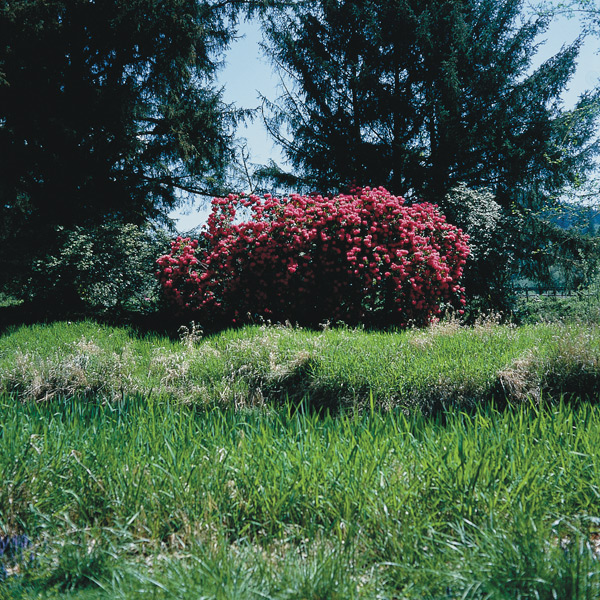
|
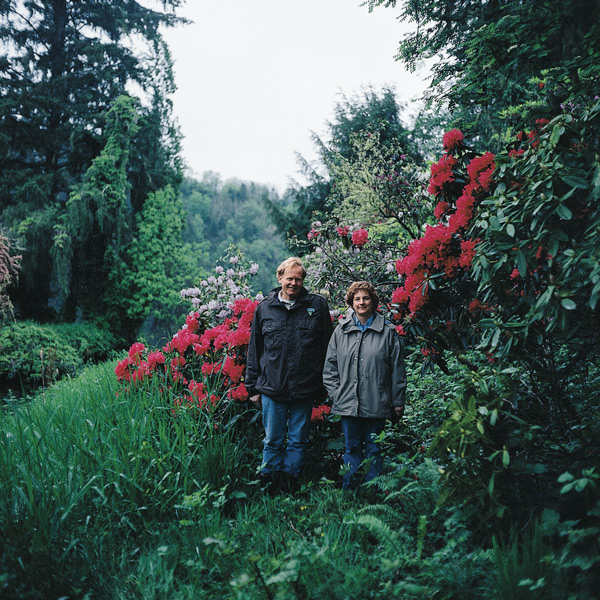
|
|
|
Unknown rhododendron in bloom.
Photo by John Hammond |
BLM Agent Kathy Wall and Umpqua Park Ranger Bob Golden.
Photo by John Hammond |
Salvage logging of merchantable timber in the B.L.M. Districts of Coos Bay, Roseburg and Eugene resulted in 82 timber sales contracts, representing 510 million board feet, purchased by 20 separate timber companies (15). As a result of the financial impact of the court actions most of O. Howard Hinsdale's operations began to be put up for sale or closed down and, unfortunately, the local communities became casualties of the fire, as to some extent did Spruce Reach Island house and garden. In August 1969 Howard sold the U.R.N. Co. to the Bohemia Lumber Company of Eugene, becoming a vice-president of Bohemia as part of the deal, and moved home to Portland.
According to local tradition Howard had marriage problems around the time of the Oxbow Fire and he and his wife separated. He subsequently married Elizabeth Fields, the widow of the owner of Fields Chevrolet, a large auto dealership in Portland. They had a house and property on S.W. Riverwood Road, Lake Oswego, Portland, where they laid out a new garden looking out over the Willamette River and they took an interest in the Portland Garden Club (21). Jane Hinsdale, Howard's first wife, continued to live at the Spruce Reach property for a couple of years after the separation.
Howard had been the president of the Umpqua National Bank of Reedsport since the day it opened for business, and in May 1970, it merged with the Oregon Bank, with Howard serving on the board of directors of the merged company. After the Oxbow Fire Howard had no further use for the property on the banks of the Umpqua and, with the passing years, the gardens on Spruce Reach Island became wild and overgrown. The timber house gradually deteriorated until it reached a stage where it would have been very expensive to restore as it was no longer to code and was in poor repair.
Oscar Howard Hinsdale, Sr., passed away in the Portland area on February 3rd, 1987 (19), and his wife Elizabeth Fields Hinsdale inherited the Spruce Reach Island property (20). Howard's son, Oscar Howard Hinsdale, Jr., subsequently became owner of the property, and in conversation with Betty Spady of Salem, he explained that as he no longer used the property as a home he sold it to the B.L.M. in 1994. He now lives in Salem, Oregon, where he manages a wine distribution business, probably dating back to the company setup by his father and John Henny.
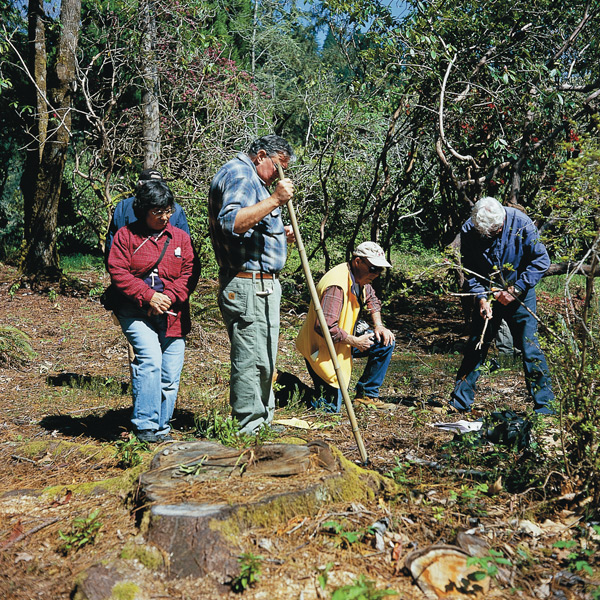
|
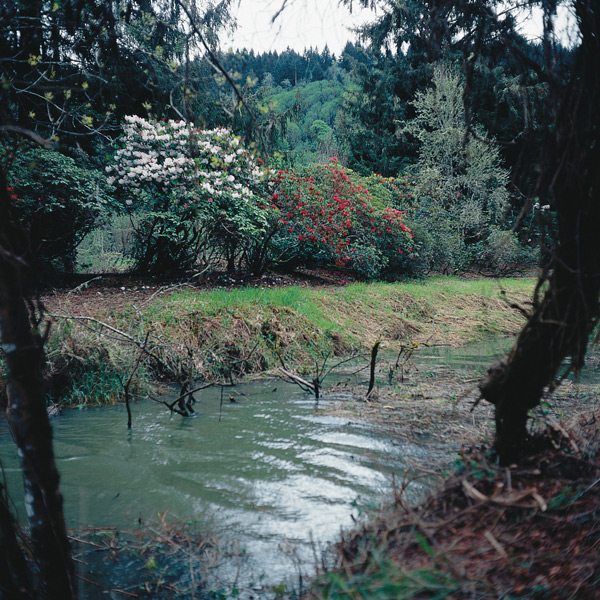
|
|
|
Maria Wartnick, Bob Macintyre (Southwestern Oregon), Gordon Wylie (Eugene)
and Gene Cockeram (Siuslaw) in garden April 2007). Photo by John Hammond |
View from house area across slough showing rhododendrons, especially
illustrating reflective water mentioned in text. Photo by John Hammond |
Restoration Proposals
In 1998 Nancy Lee, a long-time resident of the Reedsport area, noted in an email to Betty Spady that the local residents were having a battle with the B.L.M. over the proposed destruction of the old Hinsdale residence and beautiful botanic gardens (10):
I am in the battle with the Bureau of Land Management to save a historic landmark, the Hinsdale house, 4 miles east of Reedsport, whereby the BLM is proposing to tear it down...
We have formed a group, "Friends of Spruce Reach Island...and I guess I am the acting leader...We had an open house weekend Mar 21/22...over 650 people toured this house this last weekend...I had worked at cleaning the house for weeks when I had to call upon my relatives for help...They came to my rescue to make this open house successful...But I couldn't get enough info to them in time to help with the guided tours...One other lady helped to do a couple tours & I did the rest...I toured 350 people thru the house in 5 hrs on Sunday...non stop... no lunch...no sitting down...no personal visiting for more than a minute with anyone...(except Saturday I got to 'visit' with State Senator Tarno for 30 min or so...) It is only because of my family's efforts to help me & support me when I was in "real need" were we able to see this successful project happen... Many other friends came to my rescue too as the Mar 21 date was upon us... The public has until May 31, '98 to send their written comments to BLM regarding the demolition of the house. Townspeople are up in arms over the BLM's proposal...& now I hope they are MORE so up in arms after seeing how nice the house looked...Now people are wanting a 2nd open house cause they didn't get to come last weekend...maybe the "Friends" group will have another open house organized (10).
Subsequently the B.L.M. prepared a number of documents including an Evaluation Report (3), Cost Estimates, Summary of Amendment Actions and two Dean Creek Plan Amendments. No significant remedial work was taken forward on Spruce Reach Island as a result of these documents; however the house was not torn down.
References
1.
History of the Pacific Northwest, Oregon and Washington
, North Pacific History Co. 1889. Volume I. 2. Bryce, G. 1900. The Remarkable History of the Hudson Bay Company. Sampson, Low, Marston.
3. Beckham, Stephen Dow. 1996. Spruce Reach Island: Historical Assessment of the O. Howard Hinsdale House, Douglas County, Oregon. A Report submitted to the Bureau of Land Management, Coos Bay District, North Bend, Oregon.
4. Anonymous. 2004. 2004 Elliott State Forest Management Plan. Chapter One. State of Oregon, Management of State Forests.
5. Anonymous. 1871. Another Pioneer Gone (Obituary of Sylvester D. Hinsdale).
Roseburg Ensign
, Roseburg, Oregon. January 7, 1871.
6. Baxter, Galen. 2005. Notes of meetings in Eugene, OR, with the authors to discuss O. Howard Hinsdale and his garden. May 3 & September 7, 2005.
7. Burkhardt, D.C. Jesse. 1994.
Backwoods Railroads. Branchlines and Shortlines of Western Oregon
. Washington State University Press, Pullman, WA.
8. Hammond, John M. 2004. Mr. Magor and the North American triangle : an historical perspective.
Jour. Amer. Rhod. Soc
. 58:135-148.
9. Labbe, John T. & Goe, Vernon. 1961.
Railroads in the Woods
. Howell-North, Berkeley, CA.
10. Lee, Nancy & Spady, Betty. 1998. Effort to save Hinsdale property in Reedsport, Oregon. A.R.S.,
R & A. News
, Issues 2 & 3, 1998.
11. Anonymous. 1914. Local News.
Roseburg Review
, Roseburg, Oregon. March 24, 1914.
12. Anonymous. 1914. Gardiner to have a bank.
Port Umpqua Courier
, Reedsport, Oregon. October 17, 1914.
13. Oregon State Archives. 2005. Oxbow Fire State Records 1966-1970. Department of Forestry Records Guide, Oregon Secretary of State.
14. Oregon State Court Decision. 1970. 258 Or.10; State Forester v. Umpqua River Navigation Co. Reversed and remanded December 23, 1970.
15. Shepherd, Ed. 2004. Restoring Forests after Catastrophic Events. Statement by The Bureau of Land Management, Washington, DC. July 15, 2004.
16. Perkins, Nelson S. 1972. Vancouver Plywood Company : Monograph No.12. Plywood Pioneers Association, Tacoma, Washington.
17. Clark, Harrison. 1967. Weed and Long-Bell: Monograph No.3. Plywood Pioneers Association, Tacoma , Washington.
18. Anonymous. 2006. Natural Hazards Mitigation Plan. Windstorms Chapter. State of Oregon, Emergency Management Plan.
19. Oregon Death Index Records, State Registrar, Department of Human Services, State of Oregon, Portland.
20. Department of Probate, Circuit Court of the State of Oregon for the County of Multnomah, Portland.
21. Anonymous. 1987. Oscar H. Hinsdale dies.
Oregonian
, Portland, Oregon. February 4, 1987.
22. Anonymous. 1958. Hinsdale Gardens Enjoyed By Many Hundreds Sunday.
Roseburg News-Review
, Roseburg, Oregon. May 3rd, 1958.
23. Anonymous. 1954. Giant Cedar Trucked to Coast Home.
The Oregonian
, Portland, Oregon. August 5th , 1954.
John Hammond, a member of the Scottish Chapter, has contributed several articles to the Journal on garden history, including "Mr. Magor and the North American Triangle: An Historical Perspective," in the Winter 2004 issue. Gordon Wylie, a member of the Eugene Chapter, is a past president of the ARS.